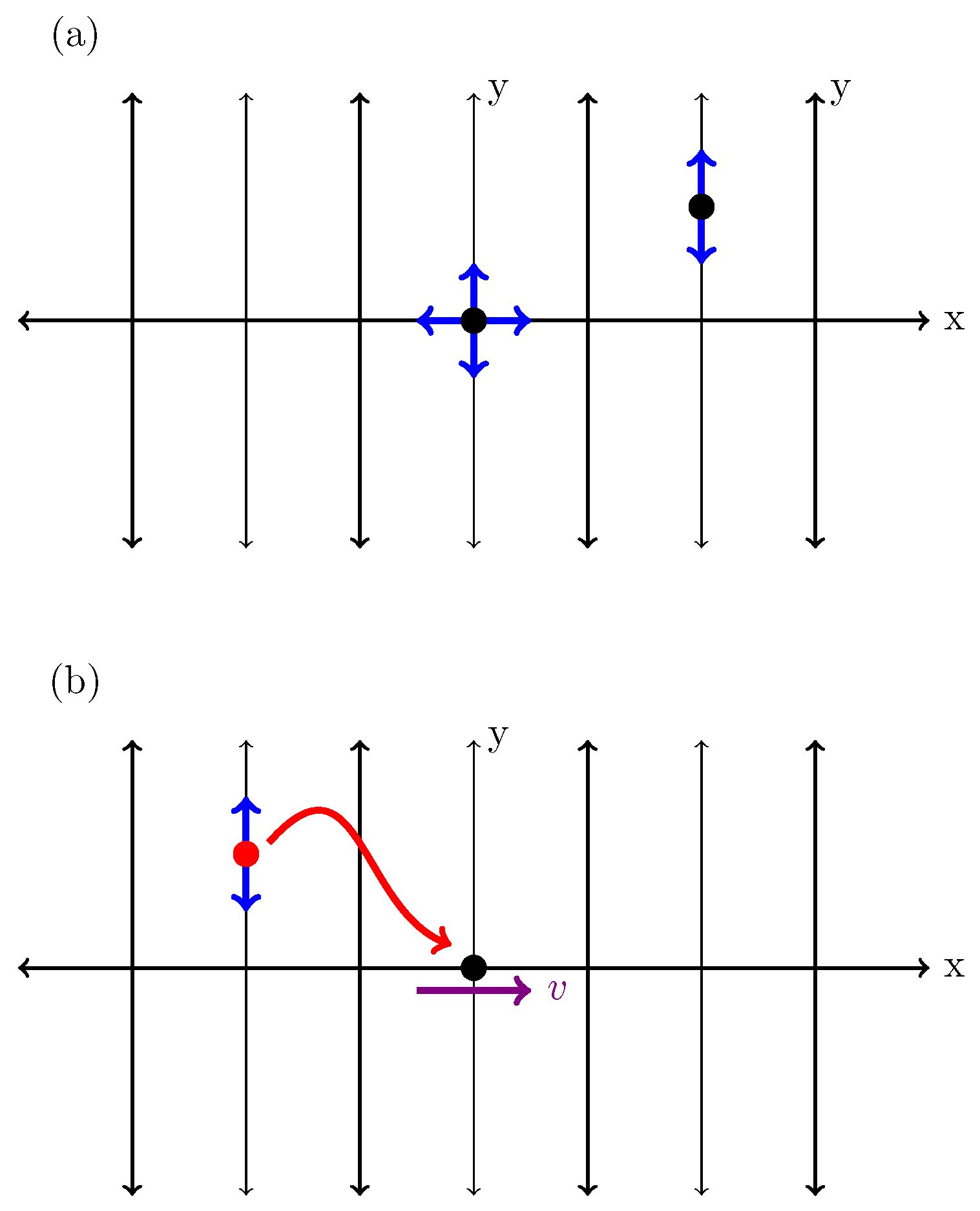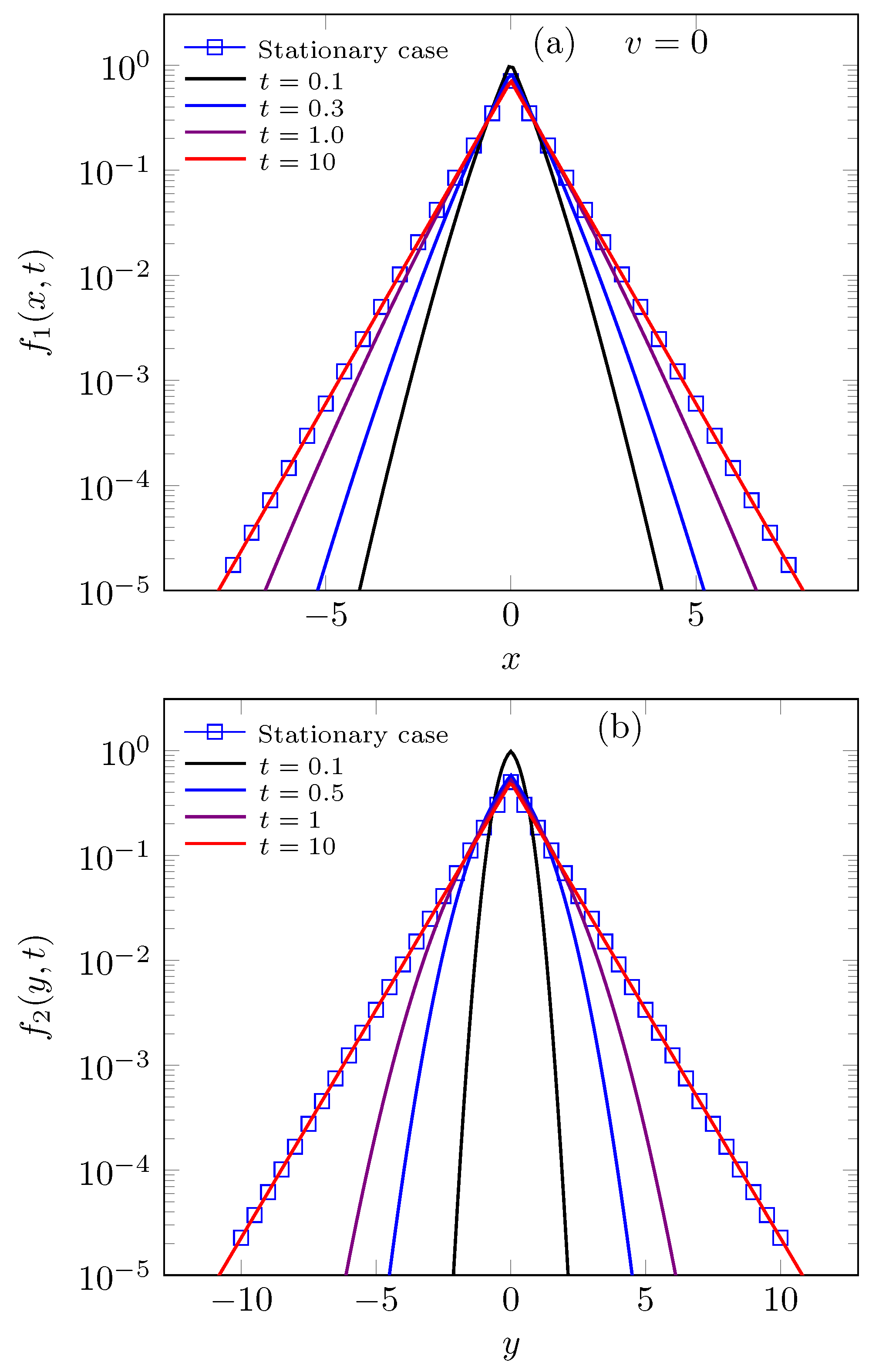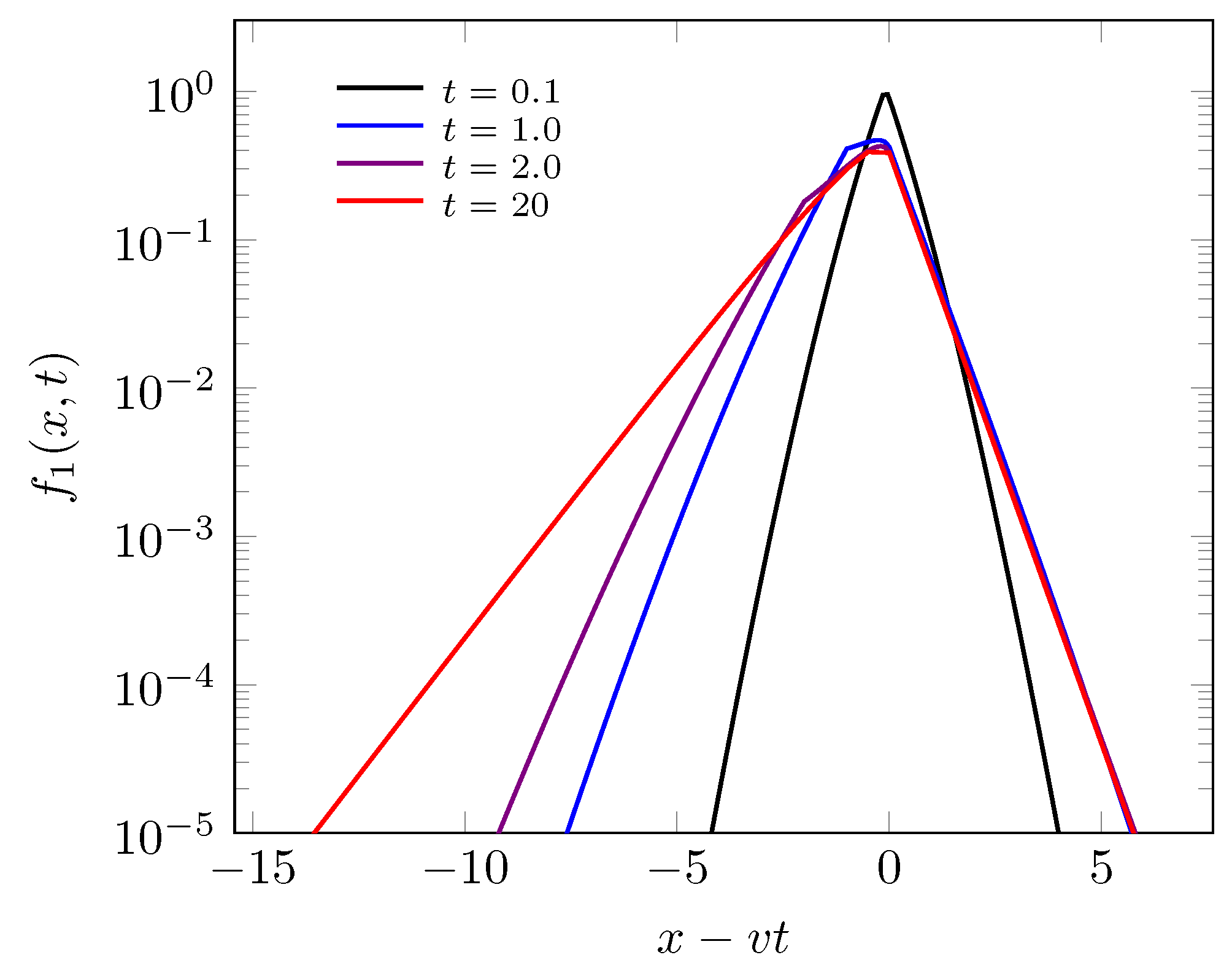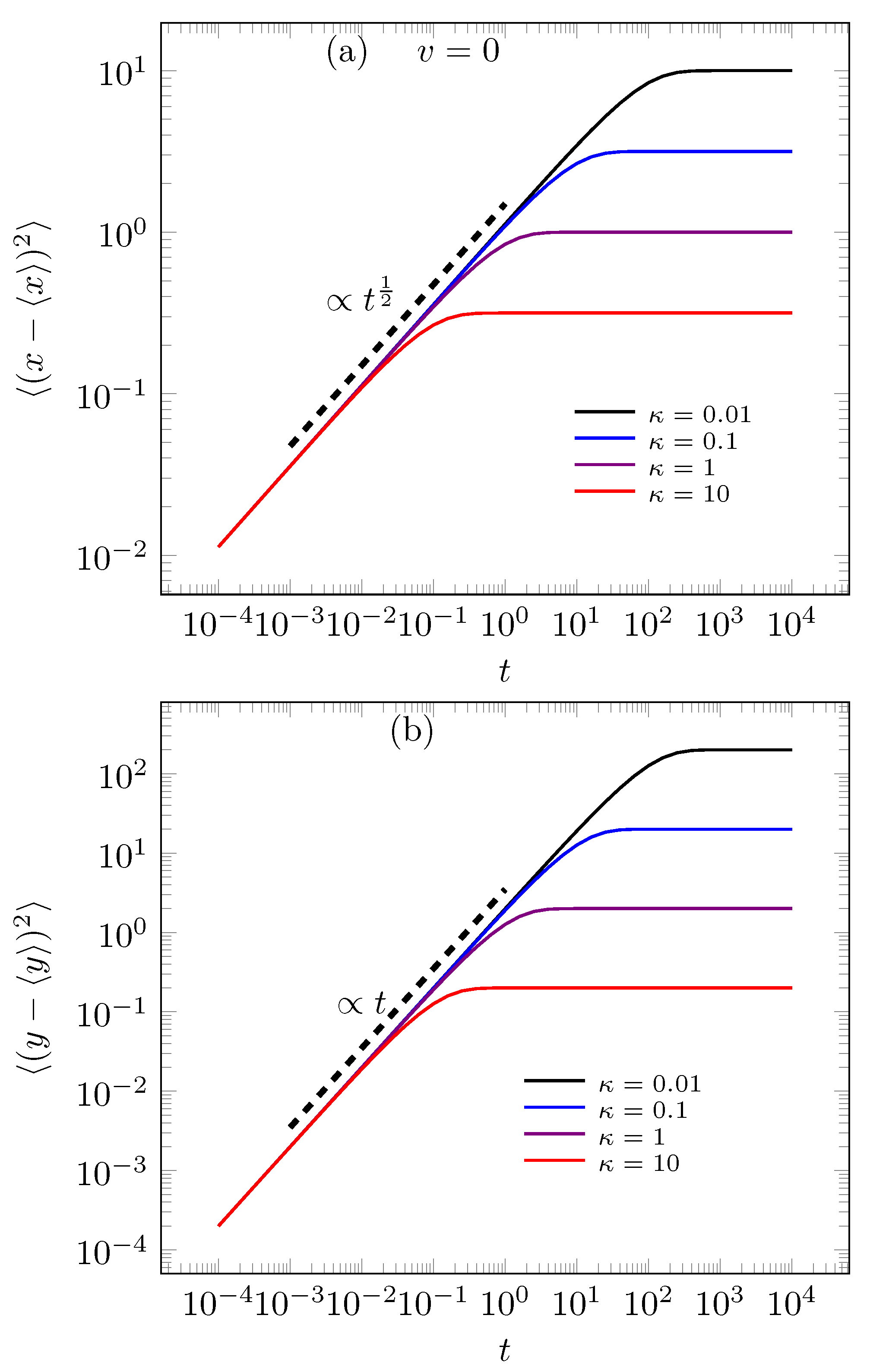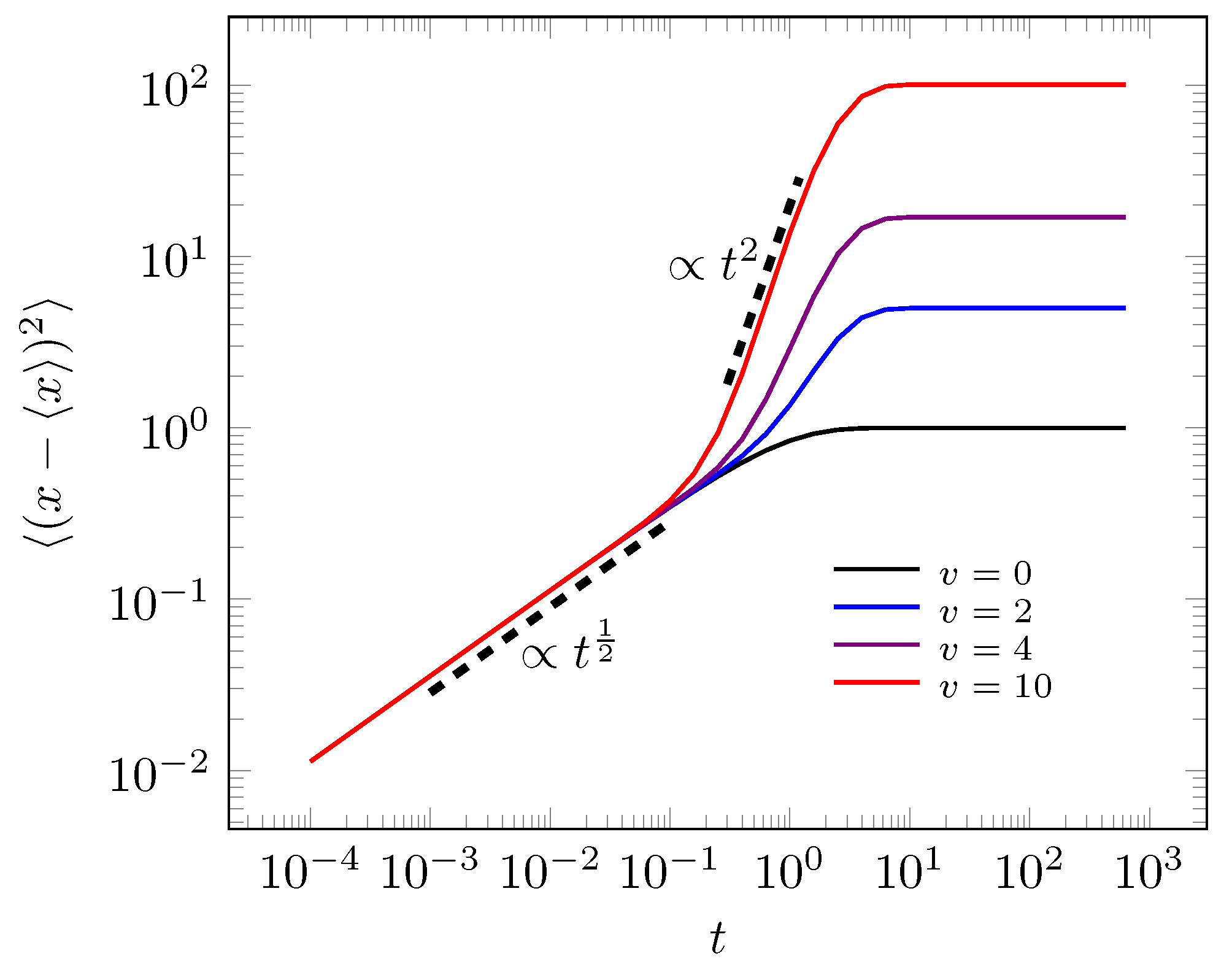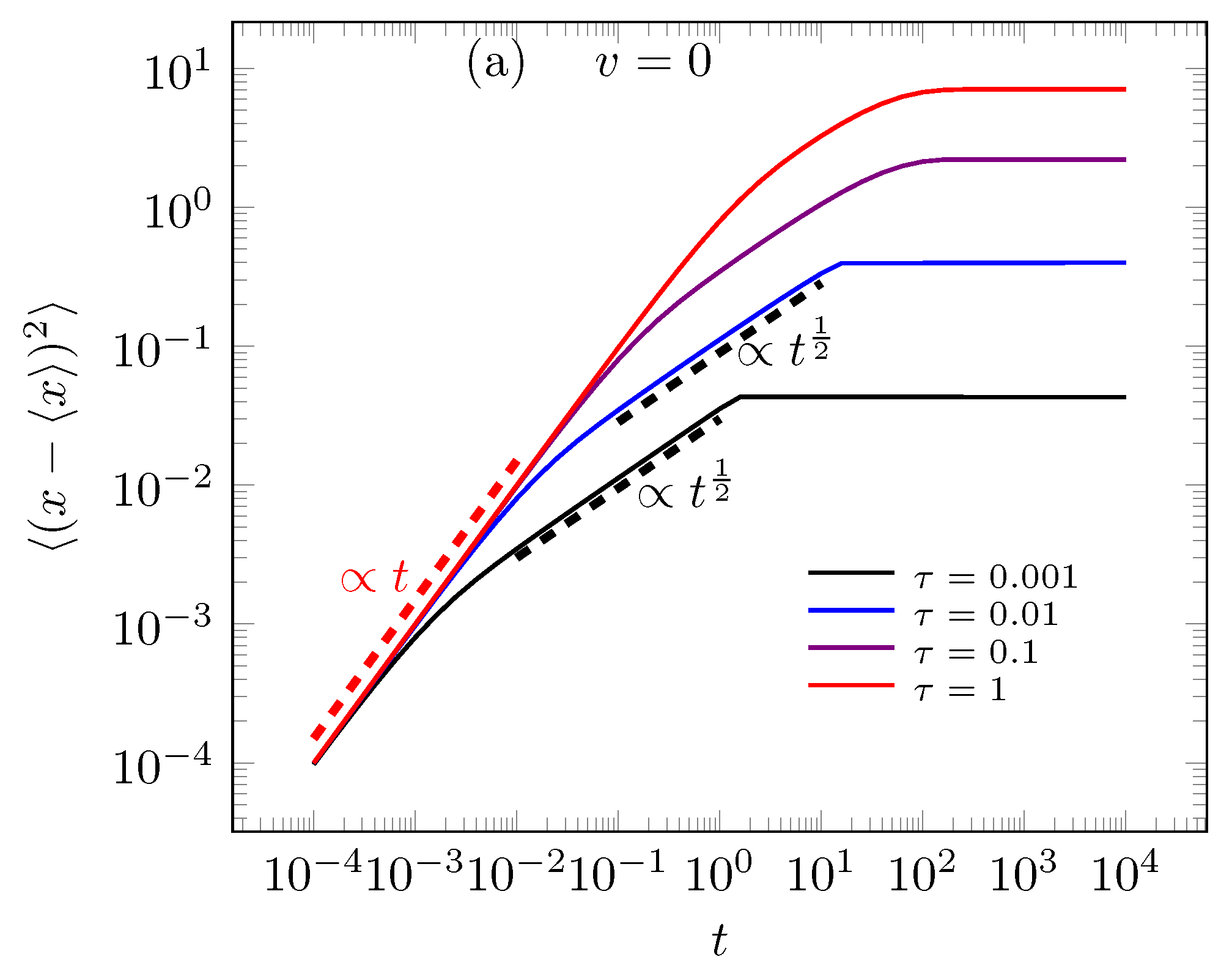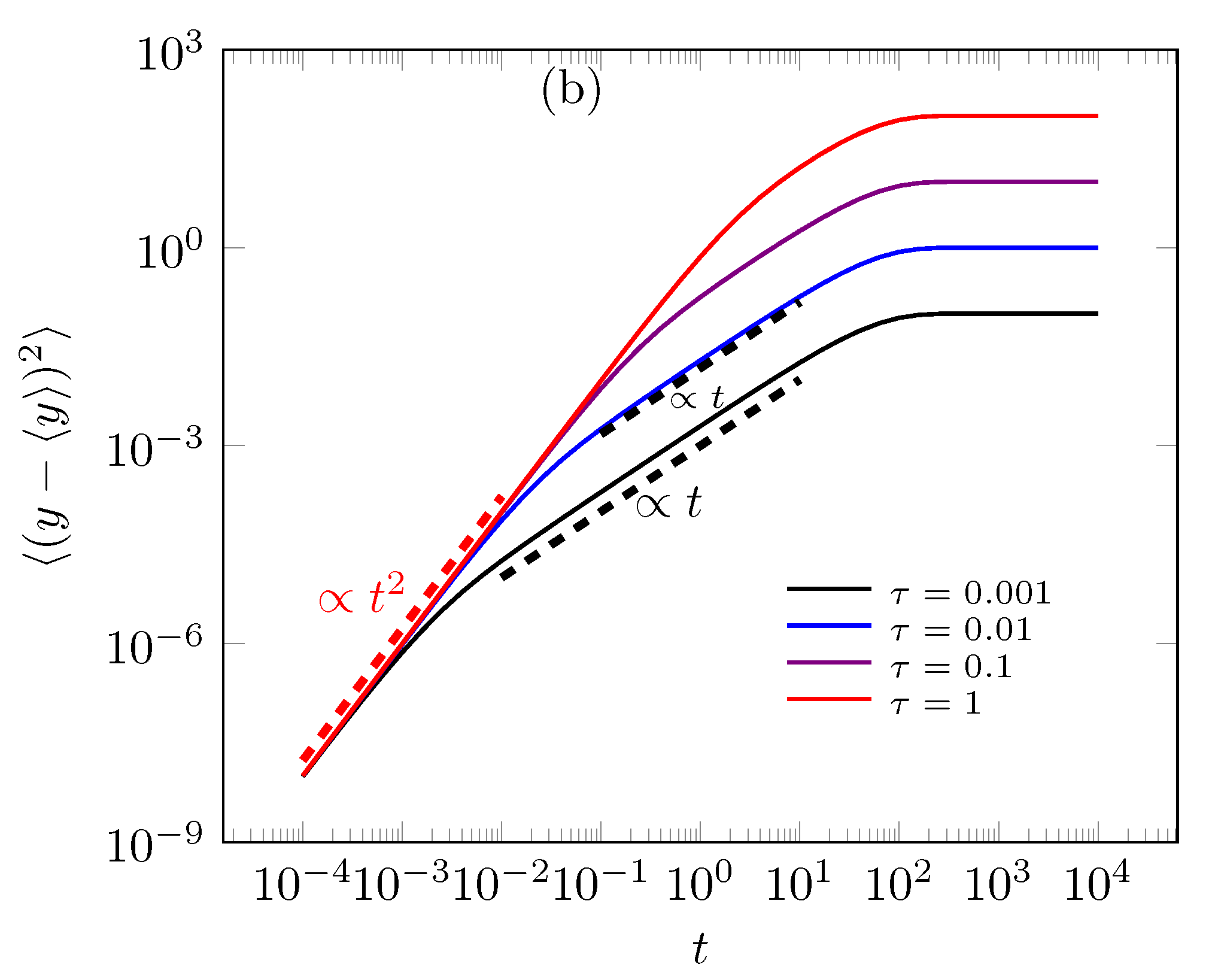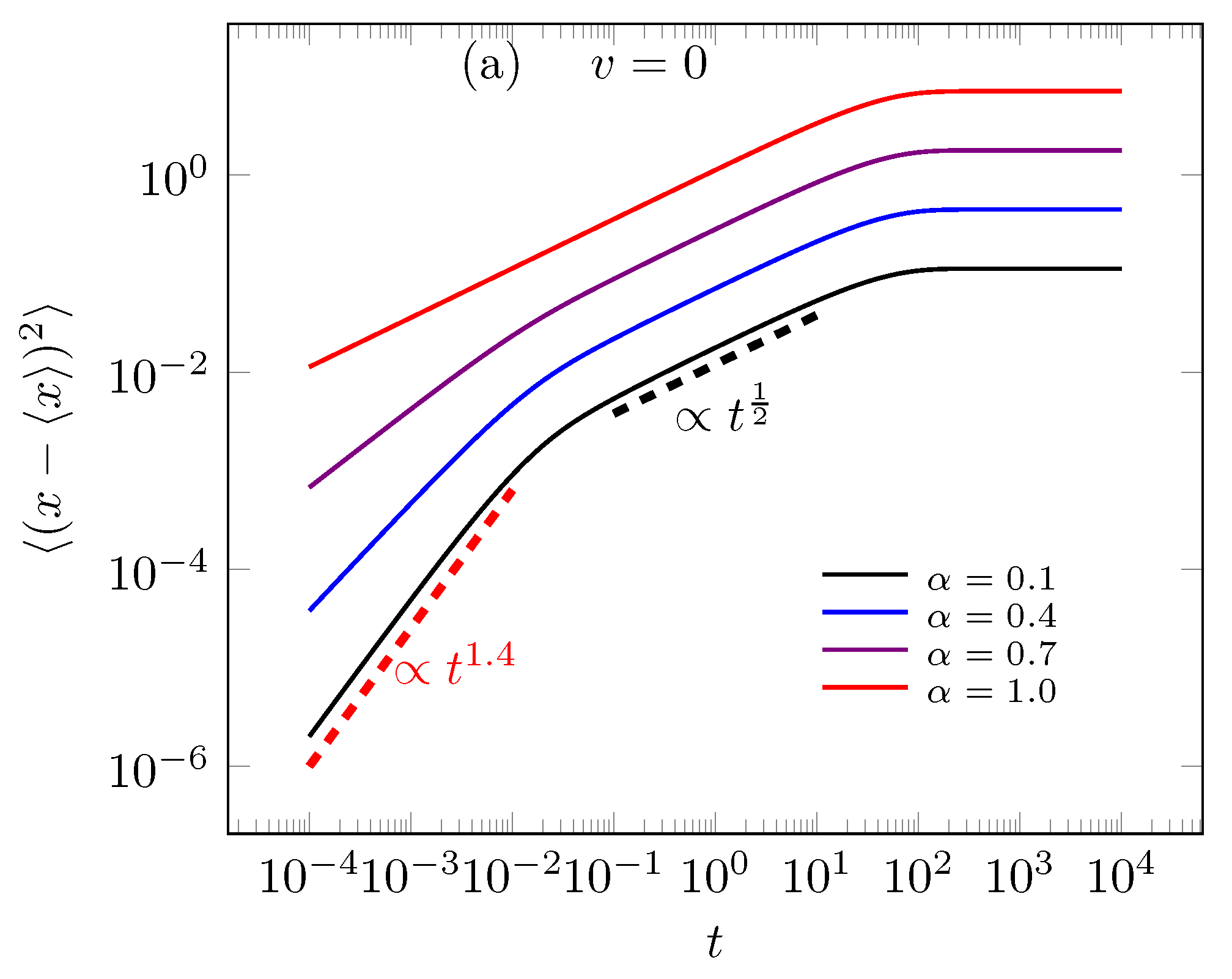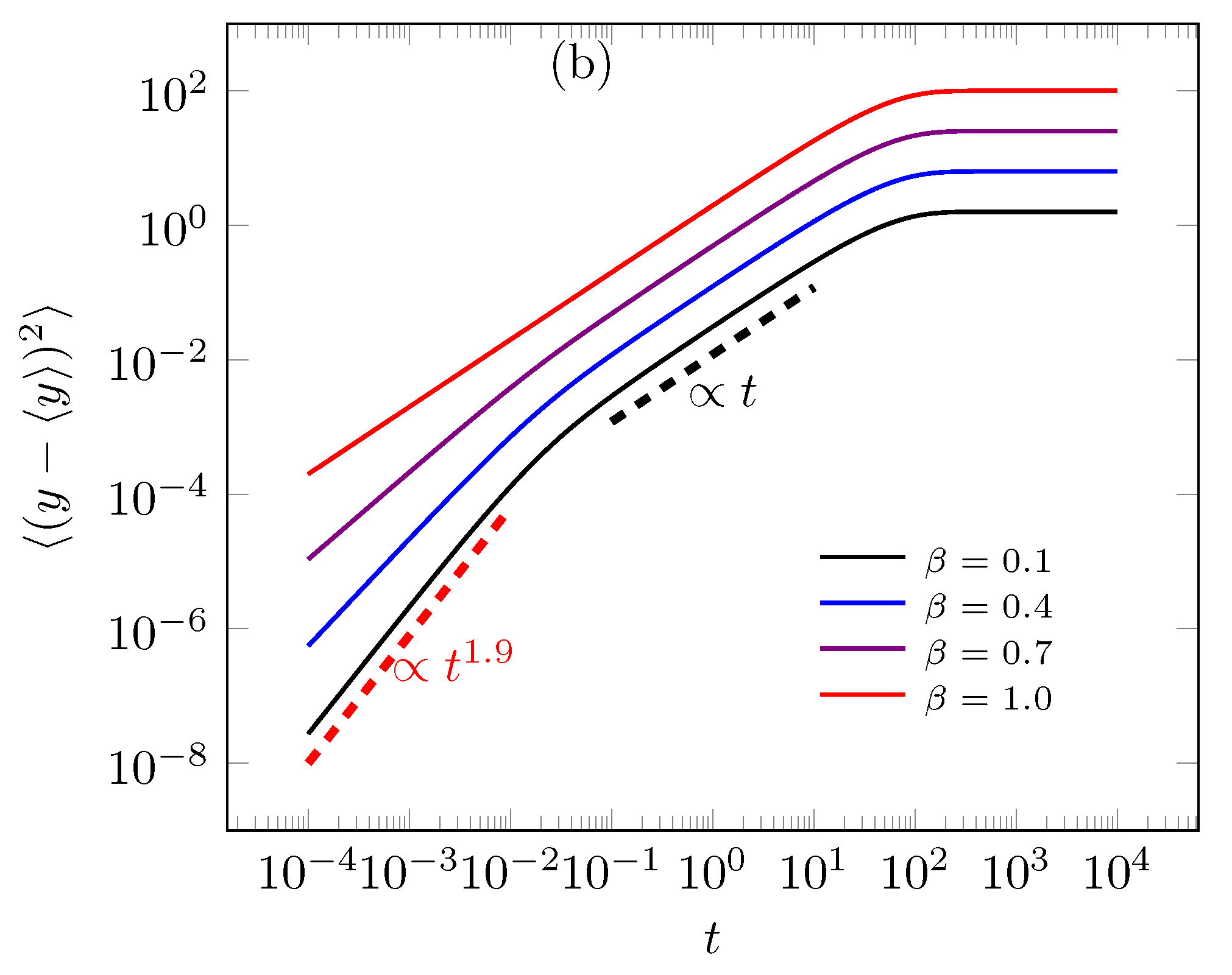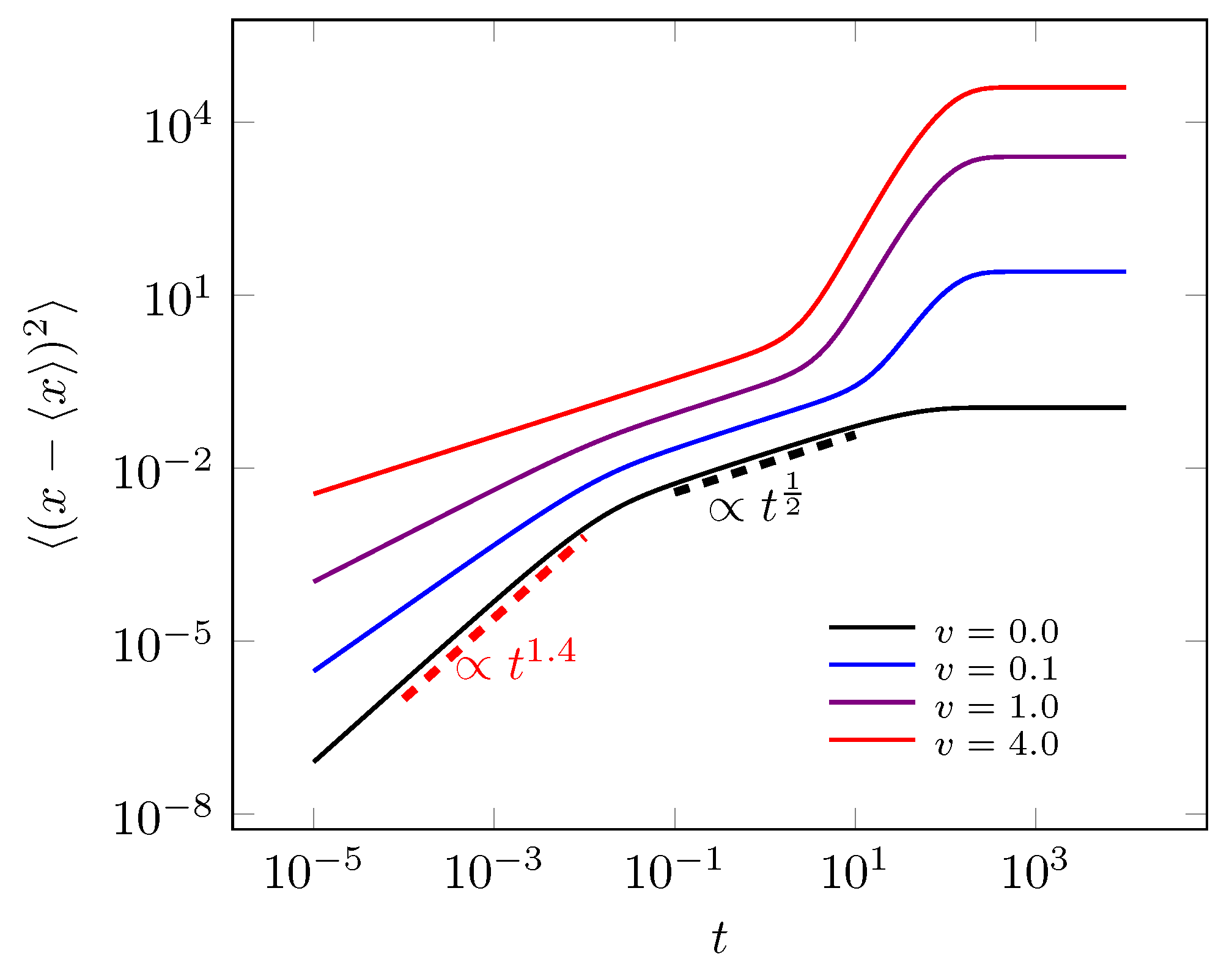1. Introduction
The statistical models in physics offer ways to understand the implicit behaviors of the stochastic process in nature. Therefore to find suitable tools and models to describe them is crucial to advance the understatement of a natural and artificial stochastic process. Currently, the stochastic resetting process have attracted the attention of many researchers. This kind of process admits that the systems return to initial condition after a time chosen randomly, so the system starts the random process again and again. Thereby, the stochastic resetting models have found applications in backtrack recovery by RNA polymerases [
1], non-equilibrium physics [
2], first passage under stochastic resetting [
3,
4], and others [
5,
6]. In this context, the stochastic resetting to random walks was proposed through a diffusion model [
7] by M. R. Evans and S. N. Majumdar. This model [
7] has been investigated in contexts as optimization of search process [
8,
9], coagulation process [
10], anomalous diffusion process [
11,
12], fractional calculus to include Lévy flights in stochastic resetting model [
13]. The works [
12,
14] use new fractional-time derivatives in stochastic resetting models to do a unified approach with anomalous diffusion process. Furthermore, the diffusion equation with stochastic resetting can also be interpreted in terms of exponential memory kernel [
15].
The main feature of usual diffusion (or free Brownian diffusion) is a linear evolution of time to the mean square displacement, i.e.,
. Nevertheless, the class of phenomena which is not described by the usual diffusion is commonly known as anomalous diffusion (or fractional diffusion), and can be classified by power-law function like
, in which
(
is a distribution function). To
the system is sub-diffusive, to
occurs the super-diffusion. In particular cases, to
the diffusion is ballistic and for
occurs the hyper diffusive process. These type of diffusion typically is approached through the fractional calculus that deforms a differential operator in diffusion equation that becomes a generalized diffusion process [
16,
17,
18,
19,
20,
21,
22]. Here, it is important make clear that anomalous diffusion phenomena go beyond of these formalisms and appears as a natural consequence in many statistical physics problems to theoretical and experimental contexts associate to different mechanisms [
23,
24].
In this broad scenario of the anomalous diffusion in complex structures, the greatest advances came in the 1980s, when fractal geometry was introduced by B. B. Mandelbrot [
25,
26], and has been extensively investigated in the most diverse situations in nature. In a fractal, the diffusion in general is anomalous since the fractal dimension
is linked to the mean square value as follows:
with
. When
we have euclidean space, which implies the usual diffusion. Based on fractal geometry, Gefen et al. [
27] demonstrated theoretically the occurrence of anomalous diffusion in percolation clusters in critically (that is, at the transition threshold). This result was confirmed through numerical simulation, which was based on the Monte-Carlo method and the random walk by Daniel ben-Avraham and Shlomo Havlin (1982) [
28], H. Panday and Dietrich Stauffer (1983) [
29]. In this direction, White and Barma’s model [
30] is based on the random walk in a linear chain (backbone) of uniformly spaced sites. From each backbone site, there are finite linear chain (a branch) of sites. These branches occur in the direction of the field and their length is given at random employing the probability distribution. Due to the resemblance to a comb, the backbone corresponds to the stem and branches. This structure was called random comb, comb-like structure or comb model. A continuous description of the random walk for the comb model was proposed in 1991, by Arkhincheev and Baskin, in the article entitled Anomalous diffusion and drift in a comb model of percolation clusters [
31]. The main idea is to modify the two-dimensional diffusion equation as follows
and
being the diffusion coefficients in the directions
x and
y. The Equation (
1) gives us the following quadratic deviations
and
, which is anomalous in
x direction. The diffusion in the direction is anomalous, demonstrating that the geometric restrictions in the system naturally imply anomalous behavior for the diffusion. In addition to elucidating some concepts about diffusion and revealing connections with clusters and fractals, the comb model can be used to describe the dynamics of ions in neuron dendrites [
32]. Indeed the comb structure has been the scene of many important problems in statistical physics. Recently, a series of investigations have been carried out using several diffusive models on comb structure, we can mention some of these advances: models associated with sub-diffusive processes on fractal comb [
33], heterogeneous diffusion models on comb structure [
34], first passage problem associated with systems that remove particles on the structure of the comb [
35], a random search for target [
36] and fractional kinetic on comb structure [
37]. In this sense, this work brings a detailed study about non-static stochastic resetting [
12] on comb structure. In the following, we analyze the anomalous diffusion crossovers caused by memory effects.
Inspired on diffusion in complex structures models, this work proposes a diffusion model suitable to approach the stochastic resetting process phenomena on comb structure. In
Section 2, we propose the model and explain the main aspects of the comb structure, finding the exact solution and their stationary limits. Moreover, we achieve the MSD behavior to short times which present sub-diffusive process in
x direction and usual diffusive process in
y direction. In
Section 3, we consider the model proposed by us under the point of view of the memory kernels in diffusive terms. In this sense, we present the analytical expressions to
and
averages that revel a rich class of anomalous diffusion behaviors which include crossovers among them. Finally, in
Section 4, we draw conclusions and outline some perspectives.
2. The Model
The comb model was initially introduced to investigate anomalous diffusion in percolation clusters according to [
30]. Considering our perspective, here we examine the comb model (Equation (
1)) with an additional term that represents the stochastic resetting process as follows
in which
consist in a bi-dimensional version of a recent purpose of non-static stochastic resetting [
12] which is write as follows
in which the static case occurs to
[
7] we recovered one of particular cases approached by A. A. Tateishi in Ref. [
38]. Moreover we have the boundary conditions and initial condition defined by
The
and
in Equation (
2) are diffusion coefficients in the
x and
y directions. The presence of the Dirac delta in Equation (
2) implies that the diffusion in the
x-direction only occurs when
, see the walker represented by a black point on
x-axis in
Figure 1a. Consequently, the diffusion in the
y-direction always occurs perpendicularly to the
x-axis, see the black point out of the
x-axis in
Figure 1a. Term (
3) in Equation (
2) permits the occurrence of the stochastic resetting on a non-static position, so the term
remove randomly the walker in a system with a rate
and the term
relocate the removed walkers in position
, see the red point in
Figure 1b which represents a walker that is relocated in the black point that moves on time with
v velocity.
Now, to find the solution to Equation (
2) with condition (
4) we consider the
and
that are the Fourier and Laplace transforms, respectively. Assuming the Fourier transforms on
and a Laplace transform on time
t, we obtain
Realizing the inverse Fourier transform under
variable we obtain
Considering
in Equation (
6), we obtain the exact solution to
as
that permits to rewrite the Equation (
5) as follows
To simplify our analysis, we consider the marginal distribution functions as did in Ref. [
39], which imply the definitions
and
Using the marginal distribution functions (Equations (
9) and (
10)) and solution in Fourier–Laplace transform in Equation (
8), we obtain
and
Here, we need realize inverse transformations to show the exact solutions to marginal distributions in terms of the
coordinates. Let us solve the inverse Laplace transform of the Equation (
11) by use the Prudnikov table [
40] that possibility the inversion of a general function
opening a way to find the exact solution to marginal distribution
as follows
in which
Then, by realizing the inverse Fourier transforms of function
, i.e., (
13), we obtain
in which
That for static stochastic resetting case, i.e.,
, we obtain the follow particular solution
that applying the Tauberian theorem, i.e.,
in Laplace transform of Equation (
17), that implies stationary solution
This stationary solution revels that marginal distribution in x-axis is influenced by dynamical proprieties of y-axis.
The inverse transform of the Equation (
13) in Fourier and Laplace space is written as follows
that for a long time implies stationary marginal distribution
The stationary solution in
y-axis coincides with Evans–Majumdar result [
7] to uni-dimensional problem. The marginal solutions (
15) and (
19) make it clear that stochastic resetting affects only the marginal distribution in
x-axis.
The time evolution of distributions associate to static restart point (
), i.e., Equations (
17) and (
19), are presented in
Figure 2. Moreover,
Figure 2a,b contains dotted curves that represent the stationary solutions (
18) and (
20), it shows that system could find the equilibrium to
when
and
.
Figure 3 shows the distribution shape in relation to
, that for high valuer of time the distribution shapes converge to red one. The non-static stochastic resetting was explored to fractional diffusion in one dimension case in Ref. [
12].
The mean square displacement (MSD) can elucidate the diffusion types to short time valuers. Here, we have
, the same to
(
). In this sense, we can define generalized natural moments
and
through the marginal distributions as follow
Using the Equations (
15) and (
19) and Equations (
21) and (
22) we obtain
For long time valuers we have the asymptotic limits
and
. For short time (
) the diffusion in relation to the
y direction obeys the usual behavior, i.e.,
, and to
x direction we has
. All this asymptotic behaviors are exemplified in
Figure 4a,b for static case, i.e.,
. The non-static case was presented in
Figure 5, which presents a crossover between sub and ballistic diffusive regimes before the system reaches the equilibrium. The ballistic regime is exclusively due non-stochastic resetting process before the system comes out of inertial state.
A parallel research was made by V. Domazetoski et al. in Ref. [
41]. The authors consider the stochastic resetting problem in 3-dimensional comb-like structure. In fact, the marginal distributions in Laplace space to particular of static resetting case (
), i.e., Laplace transform of Equations (
17) and (
19) correspond to marginal distribution in Laplace space found by V. Domazetoski et al. in Equations (40) and (41) in Ref. [
41]. Then, the first part of our results coincide only in this specific point with their respective MSD, which is a clear signal of a very effervescent research line. Moreover, in the next section, we consider memory kernels in Laplacian terms with kernels that are connected with a Cattaneo process types.
3. The Model with Memory Kernels Effects: Crossover between Anomalous Diffusion Regimes
The memory effects in diffusion process have been investigated in many current problems [
14,
17,
18,
19,
42]. This memory kernel techniques have been a suitable tool to introduce anomalous diffusion in transport models. In this sense, here we rewrite the model (
2) with general convolution kernels on diffusive terms
and
as follows
in which boundaries and initial conditions were presented in relations (
4). Realizing the Laplace transform on time
t and Fourier transforms on
in Equation (
25), we obtain
that has the same mathematical structure of Equation (
5). Then, as in previous calculus we obtain the follow solution in Laplace-Fourier space
Thereby, using this general relations in Equations (
21) and (
22) we obtain the follow equations
Now, we consider two cases to analyze the memory effects in non-static stochastic resetting on comb structure. To assure the non-negativity of marginal distributions (safe ones) [
43] we consider a kernel class that implies two marginal solutions in Laplace space that can be identified with non-negative uni-dimensional solution of generalized diffusion equations. The first one is an exponential memory kernel that connects the marginal solutions in Laplace space to well known uni-dimensional Cattaneo diffusion equation [
44] or finite velocity effect on comb structure [
37,
39]. The second one is a tempered power-law kernel that connects the marginal solutions in Laplace space to uni-dimensional Prabhakar-tempered diffusion equation [
45] to specific choices of the fractional index. Then, to consider other kernel classes the conditions investigated by I. M. Sokolov in Ref. [
43] need be verified to avoid the negative solutions.
3.1. First Case: Exponential Memory in Diffusion Terms
The exponential kernels in convolution term of diffusion equation implies a memory effects associate to Cattaneo equation, see Ref. [
44,
46] for more details. Therefore, we write the kernels as follows
The inverse Laplace transforms of Equations (
28) and (
29) combined with memory kernels (
30) imply
and
in which
is a modified Bessel functions. To short time, we obtain the usual behavior in
x-direction, i.e.,
, and the ballistic behavior in
y-direction, i.e.,
.
Figure 6 presents the MSD behavior on time to different
valuers in exponential memory kernels with
. Thereby,
Figure 6a,b to small
valuers and
presents the sub-diffusive (
) and usual diffusive regimes (
), respectively. The non-static case (
) in MSD appears on
x-axis in
Figure 7 that displays three diffusive regimes before the system reaches the stationary state from MSD point of view, more specifically the MSD in
x-axis present ballistic, usual and hyper diffusive regimes to
.
3.2. Second Case: Tempered Power-Law Memory in Diffusion Terms
The second case consider a mix of power-law kernels with exponential factor. This operator types is well known in the literature by tempered memory kernels, a remarkable feature is the truncation in power-law functions [
47]. Thereby, we can write they as follow
in which
and
. The tempered kernels involve a mix of two or more functions to approach generalization of the fractional stable statistics [
48]. Then, the “tempered” kernel types allow suitable truncation effects which imply crossover process among diffusive process [
45,
49,
50]. The tempered kernels ((
33) and (
34)) in Equations (
28) and (
29) imply the follow inverse expressions
and
These MSD revel that for short time (
) we have
and
as presented in
Figure 8a,b, respectively. These figures present a wide class of diffusion types to static resetting case and different
parameters. Moreover, to times of order
and small
valuer,
Figure 8 shows to intermediate diffusive regimes
and
that correspond to regimes out of power-law memory influence. The non-static stochastic resetting effects appear in
Figure 9 to different velocity valuers. This figure makes clear that the there are a crossover of two super-diffusive process with a sub-diffusive process among them before the plateau state. Here, we can comment on non-truncation effect in power-law memory kernels ((
33) and (
34)). To this case, there is no exponential truncation function which implies vanishing of the intermediate behaviors
,
and
in
Figure 8a,b and
Figure 9 respectively. Therefore, the exponential truncation is responsible to the vanishing of the power-law function effects (
) resulting the crossover in MSD with a intermediate time regimes associated to the usual-diffusion on comb structure reported in Equations (
23) and (
24) before the system reaches the plateau state.
Other kernel classes can be considered in general model (
25) that can imply new annealed disorder mechanisms [
38]. Particularly considering
in model (
25) we obtain a diffusion model that for non-stochastic resetting case, i.e.,
, we obtain a particular case of comb model with slow and ultraslow diffusion investigate by T. Sandev et al. in Ref. [
51].
4. Conclusions
Daily, the stochastic process has introduced a vast quantity of new techniques and applications in nature. In this work, we investigated the non-static stochastic resetting process on comb model. The non-static characteristic allows resetting the system on a point that moves with a constant velocity v on dorsal backbone in comb structure. We presented the exact analytical solution to marginal distributions to x and y axis. Moreover, the results show that MSD behavior to x direction initially has a sub-diffusive regime followed by a ballistic regime due non-static feature, after that the systems reaches the stationary regime to MSD. In y direction the result revels that non-static characteristic has not influence, so we find a Brownian behavior to a short time, i.e., and a constant MSD for long time. Finally, we considered memory kernels in diffusion terms of the model to investigate the diffusive process in different directions on comb structure. To the first memory case, we considered exponential memory kernel, that implies MSD for short times () as and in x and y directions, respectively. Its results differ from the usual case due to the presence of the exponential kernels effects associated with Cattaneo equation type. In the second memory case, we considered a tempered power-law memory kernel that imply anomalous diffusion process to very short times (), that imply and to x and y directions, respectively. After this time regime, the system goes to a time regime () governed by a sub or usual diffusion process. Then, for times of order there is a third regime that presents super or hyper diffusion process to non-static stochastic resetting case . These results implied a robust variety of anomalous diffusion process. In fact, both memory kernels considered admit a crossover between two or more anomalous diffusion process before the system reaches the stationary state to MSD point of view.
The diffusion models introduced in this work allow to describe the transport process on comb structure with non-static stochastic resetting and memory effects. Thereby, this work opens possibilities to investigate the stochastic resetting problem for mesh and fractal grids considering different memory function associated with Mittag–Leffler functions.
